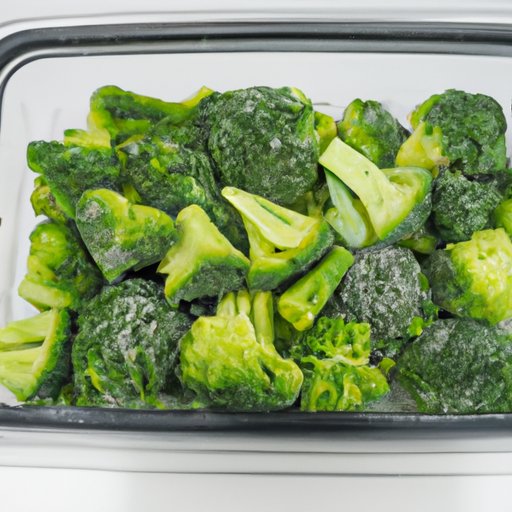
I. Introduction
Broccoli is a nutritious and delicious vegetable that requires proper storage to maintain its freshness, flavor, and nutritional value. Whether you’ve just bought a bunch of broccoli from the grocery store or harvested it from your garden, learning how to store it correctly can help you avoid common problems such as yellowing, wilting, and spoilage. In this article, we’ll explore different methods for storing broccoli, from keeping it in the refrigerator to freezing it for long-term use. We’ll also offer creative recipe ideas and tips for using up extra broccoli before it goes bad.

II. Why Proper Storage is Important
Proper broccoli storage is essential for retaining its nutritional value and flavor. Broccoli is an excellent source of vitamins, fiber, and antioxidants, all of which can be lost if the vegetable is stored improperly. When broccoli is exposed to air and moisture, it can quickly spoil and become mushy or slimy. In addition, improper storage can cause broccoli to turn yellow and lose its flavor. By storing broccoli correctly, you can maintain its nutritional value and flavor, making it a tasty and healthy addition to your meals.
III. Tips for Storing Broccoli in the Refrigerator
Storing broccoli in the refrigerator is the best way to keep it fresh for several days. Follow these tips to store it properly:
- Wrap the broccoli in a damp paper towel to keep it moist and prevent it from drying out.
- Place the broccoli in a plastic bag, squeezing out as much air as possible before sealing it. This will help keep the moisture in and prevent the broccoli from wilting.
- Keep the broccoli in the crisper drawer of your refrigerator, which is designed to maintain humidity and keep vegetables fresh.
- Make sure there is proper ventilation in your refrigerator to prevent the buildup of moisture, which can cause broccoli to spoil.
IV. How to Store Broccoli in the Freezer for Long-Term Use
Freezing broccoli is an excellent way to preserve it for long-term use, especially if you have an abundance of fresh broccoli that you want to save for later. The key to freezing broccoli is to blanch it first. Here’s how:
- Cut the broccoli into pieces of your desired size.
- Bring a large pot of salted water to a boil.
- Add the broccoli to the boiling water and cook for 3-5 minutes, until it is just tender. Be careful not to overcook it, as this can cause it to lose its nutritional value.
- Remove the broccoli from the boiling water and immediately place it in a bowl of ice water to stop the cooking process and prevent it from becoming mushy.
- Drain the broccoli and pat it dry with a paper towel.
- Place the broccoli in a freezer bag or airtight container and store it in the freezer for up to 8 months.
Be sure to label the bag or container with the date and contents so you can keep track of how long it has been stored. Blanching the broccoli before freezing helps to preserve its texture and nutrients, and prevents it from becoming freezer burnt or developing ice crystals.
V. Blanching and Freezing Broccoli for Optimal Storage
While blanching broccoli before freezing it is essential, there are a few extra tips that can help you achieve optimal results:
- Cut the broccoli into uniform pieces so that it will freeze evenly.
- Don’t overload the pot with broccoli when blanching it, as this can cause the water temperature to drop and result in uneven cooking.
- Make sure the broccoli is completely dry before placing it in the freezer bag or container, as any moisture can cause ice crystals to form.
- Remove as much air as possible from the bag or container before sealing it, as this will help prevent freezer burn.
By following these tips, you can be sure that your frozen broccoli will be just as delicious and nutritious as it was when it was fresh.
VI. Creative Ideas for Using Up Extra Broccoli Before It Goes Bad
If you have extra broccoli that you want to use up before it goes bad, there are many creative and delicious ways to do so. Here are some ideas:
- Make a broccoli and cheddar soup.
- Cook up a stir-fry with your favorite protein and lots of fresh veggies, including broccoli.
- Roast the broccoli with olive oil and your favorite seasonings for a crispy and flavorful side dish.
- Make a broccoli quiche or frittata.
- Add broccoli to your favorite smoothie for a healthy and delicious boost.
When cooking broccoli, be sure not to overcook it, as this can cause it to become mushy and lose its nutritional value. Steaming or sautéing broccoli for just a few minutes can help it retain its texture and flavor.
VII. Different Storage Containers That Work Well for Storing Broccoli
There are several different types of containers and bags that work well for storing broccoli, including:
- Plastic bags: These are a convenient and inexpensive way to store broccoli, and they can be reused several times.
- Reusable silicone bags: These are a more sustainable option than plastic bags, and they can be washed and reused many times.
- Glass containers: These are a good option if you want to see what’s inside and avoid any plastic waste.
Regardless of the type of container you choose, be sure to look for one that is airtight and has good ventilation to prevent the buildup of moisture.
VIII. Recipes for Meals Using Broccoli That Highlight Its Freshness
Here are some delicious and healthy recipes that use broccoli as the star ingredient:
- Roasted Broccoli and Chicken: Toss broccoli florets with olive oil, salt, and pepper, and spread them out on a baking sheet. Add chicken breasts to the same sheet, and bake at 400 degrees for 25-30 minutes, or until the chicken is cooked through and the broccoli is crispy and tender.
- Vegan Broccoli Quinoa Salad: Combine cooked quinoa with steamed broccoli florets, sliced almonds, dried cranberries, and a tangy dressing made from lemon juice, olive oil, and Dijon mustard.
- Broccoli and Cheese Stuffed Potatoes: Bake your favorite potatoes until they are tender, then slice them in half and scoop out some of the flesh. Mix the potato flesh with steamed broccoli, cheddar cheese, and sour cream, then stuff it back into the potato skins and bake for an additional 10-15 minutes.
When cooking with broccoli, be sure to cut it into small, uniform pieces to ensure even cooking. Don’t be afraid to get creative and try out new flavor combinations!
IX. Conclusion
Storing broccoli properly is essential for maintaining its freshness, flavor, and nutritional value. Whether you’re refrigerating it for short-term use or freezing it for long-term storage, there are several tips and tricks you can follow to ensure that your broccoli stays fresh and delicious. By blanching broccoli before freezing it, you can help preserve its texture and nutrients and prevent freezer burn. And when you have extra broccoli on hand, there are plenty of creative and tasty ways to use it up before it goes bad.




